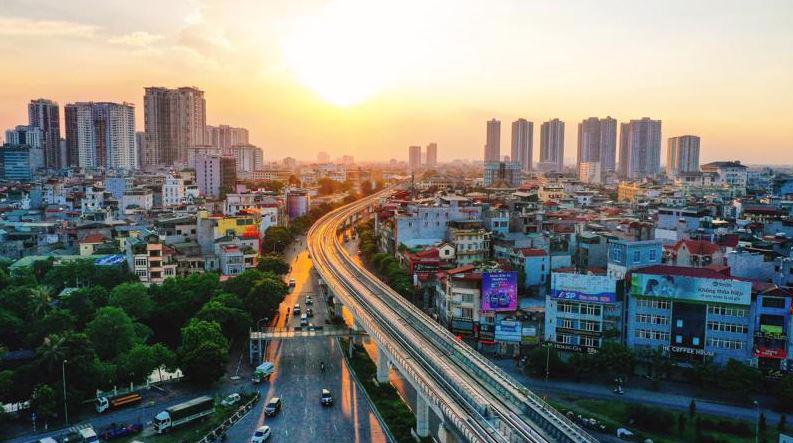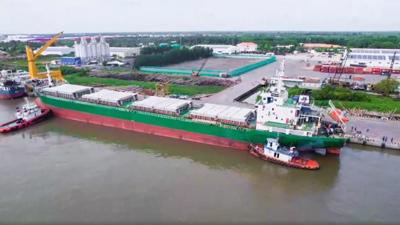Legal obstacles to real estate market to be removed
A host of real estate projects around Vietnam have been delayed by legal issues, a recent forum heard, adding to growing housing supply shortages and skyrocketing property prices.

Vietnam’s real estate market is facing a severe shortage of housing supply, with many projects stalled due to legal obstacles. This not only wastes valuable land but also pushes property prices to unsustainable levels. The struggles in the market, with few new projects emerging and large land reserves tied up in legal issues, were central to discussions at the “Specific Mechanisms and Capital Flows for the Real Estate Market” forum held recently in Ho Chi Minh City.
Three chronic “health conditions”
Though Vietnam’s real estate market is exhibiting some positive signs, experts warn that it continues to suffer from a number of deep-rooted structural problems that need urgent and targeted attention.
Addressing the forum, Professor Tran Ngoc Tho from the University of Economics Ho Chi Minh City compared the state of the market to a patient with three chronic health conditions: high blood pressure, high blood sugar, and high cholesterol.
“High blood pressure”, he explained, represents the soaring property prices that are now far beyond the reach of most Vietnamese. In many cases, home prices are dozens of times higher than average incomes, meaning it could take someone a lifetime, or even several lifetimes, to afford a home. If this is not addressed, it could lead to serious economic consequences.
“High blood sugar”, meanwhile, reflects the sector’s heavy dependence on special policies and financial sources, particularly the banking system. This overreliance, Professor Tho noted, puts the market at risk of becoming stuck if any part of that system falters.
And “high cholesterol” refers to the large stockpile of unsold properties and the mounting bad debts within banks tied to real estate assets. These conditions, he warned, could silently trigger a financial crisis, much like how plaque in the arteries can cause a stroke.
The Professor also noted that not all “cholesterol” is bad. A healthy injection of social and commercial housing could help absorb longstanding inventories and support the economy. At the same time, he called for efforts to boost supply, especially in the context of streamlined government staffing, which may lead to a surplus of public real estate assets.
In conclusion, he, and indeed other experts at the forum, believe that Vietnam must urgently tackle these chronic conditions to bring real vitality back to the market. The most immediate remedy, they emphasized, lies in increasing the supply of affordable housing and unlocking capital flows to support market recovery.
Legal reforms paving the way
When discussing solutions to boost housing supply in the market, many experts have emphasized that the key challenge is to resolve the legal issues holding up a large number of ongoing projects. “Preliminary figures show that around 1,000 projects are currently stalled, with over $30 billion tied up in them,” said Mr. Nguyen Van Dinh, Vice Chairman of the Vietnam National Real Estate Association (VNREA). “If these projects can be unlocked, it would create a tremendous economic boost, ease business sentiment, build trust, and increase supply in the market.”
Analysts are hopeful that many projects will be unlocked thanks to new laws and special mechanisms outlined in Resolution No. 170/2024, which introduces specific mechanisms and policies to remove difficulties and obstacles facing projects and land specified in inspection and audit conclusions and judgments in Ho Chi Minh City, central Da Nang city, and south-central Khanh Hoa province, and in Resolution No. 171/2024/QH15 from the National Assembly (NA) on the pilot implementation of commercial housing projects through negotiations on the acquisition of land use rights.
Professor Hoang Van Cuong, Member of the NA’s Finance and Budget Committee, pointed out that, over a long period, the legal framework has been both too lax and too flexible, leading to violations. These projects have been halted, and the officials involved have been held accountable. Investors, meanwhile, must also fulfill their financial obligations. The question is, how can these projects be resumed?
In principle, any project that has violated the law must start from scratch. Special mechanisms, therefore, would allow the continuation of these projects. Most are located on prime land, so the issuance of Resolution No. 171 by the NA provides an opportunity to unlock these projects and make better use of land resources.
Resolution No. 170 allows investors to transfer rights, offering more opportunities for investors to access different types of land and resolve issues with previously stalled projects. This is a crucial driver for revitalizing the country’s real estate market.
Mr. Dao Trung Chinh, Director of the Department of Land Management at the Ministry of Agriculture and Environment, explained that the Land Law 2024 significantly addressed critical issues. Previously, many projects faced delays because localities couldn’t determine land use fees. However, the new law resolves this by determining land prices at the time of land allocation, with a 5.4 per cent annual fee for any unfinished projects.
He also identified two types of unresolved issues. One involves reviewing projects based on existing audit conclusions, and the other requires local administrations to take the lead.
Previously, outdated laws led to conflicts, such as the case with commercial housing projects. With Resolution No. 171, however, such issues have been resolved.
Mr. Le Hoang Chau, President of the Ho Chi Minh City Real Estate Association (HoREA), shared an example. “Under the old laws, there were 86 projects in Ho Chi Minh City that couldn’t be carried out, involving 57,000 homes,” he explained. “Companies had their capital tied up, facing numerous difficulties. But now, with Resolution No. 171, these projects are gradually being unlocked. Ho Chi Minh City has already registered 343 projects covering 1,913 ha, which will result in a substantial number of homes on the market. It is estimated that 216,000 homes will be available in the next three to ten years.”
“When we invest about VND1 trillion ($40 million) for each hectare of commercial housing projects, it generates VND1,900 trillion ($76.4 billion) in investment for society, creating jobs for millions,” he continued. “This is the first time the NA has passed a special resolution to resolve 64 projects in three regions. However, there are over 1,500 projects nationwide facing similar issues. Therefore, we urge the government to apply this resolution to all regions with similar projects.”
Regarding affordable housing, particularly social housing, Mr. Vuong Duy Dung, Deputy Director of the Department of Housing and Real Estate Market Management at the Ministry of Construction, said that in addition to addressing commercial housing projects it is also necessary to promote policies that encourage the development of social housing. This is critical not only for low-income groups but also for wider social needs.
Recent policy changes, such as amendments to the Law on Housing in 2023, have already facilitated land allocation and investment procedures to encourage social housing development. The government is also working on new policies to prioritize funding for social housing development. Additionally, the government is simplifying administrative procedures and investment processes to make it easier for businesses to participate. Only with these improvements can the target of 1 million social housing units be achieved.
Reviving the market
Another key issue for the real estate market, according to experts, is the need to resolve difficulties in capital flows, especially credit from banks and corporate bonds.
Mr. Pham Phu Khoi, Vice Chairman of the Vietnam Bond Market Association, emphasized that, globally, bonds are the largest financial market instrument and five times larger than stocks. However, Vietnam’s corporate bond market remains in its infancy, with a widespread lack of understanding. The State and banks often treat bonds as loans, while investors treat them like deposits. This has led to crises in investor confidence.
He clarified that there are two types of corporate bonds. While they are technically loans, they are structured debts meant for experienced and risk-tolerant investors. Retail investors, meanwhile, need to understand that bonds are securities, and should meet clear criteria to be treated as such.
In the past, developers accessed corporate bonds too easily because it was a cheap funding source. Unfortunately, many used the funds for purposes other than project development, resulting in violations and scandals. Today, regulations have tightened around bond use disclosures. However, for new developers, issuing bonds solely for project funding remains challenging, as bank loans remain the most affordable option.
On the topic of credit access, Mr. Le Huu Nghia, General Director of Le Thanh Construction, said that while conditions have improved since 2023, challenges persist. “Before 2023, it was extremely difficult to access capital, and costs were high,” he explained. “Bond issuance failed and was only feasible for large corporations. For private firms like us, issuing bonds was too costly, and we relied on bank loans instead, which were simpler and cheaper. Today, banks are lending with reasonable interest rates. However, there used to be no specific lending package for social housing. A solution is needed for early borrowers still burdened by high rates.”
“Looking ahead, we expect capital supply to stabilize by 2025 and anticipate a market boom by 2027,” he continued. “But will banks have sufficient liquidity to meet sudden surges in demand? Bureaucratic delays of 5-6 months per case are still common.”
Mr. Nguyen Duc Lenh, Deputy Director of the State Bank of Vietnam’s Ho Chi Minh City branch, noted that the real estate market is overly reliant on bank credit. Total outstanding real estate loans in the southern city have reached VND1,085 trillion ($43.4 billion), accounting for 27.5 per cent of total credit and growing faster than overall credit. Therefore, it is inaccurate to claim that banks are obstructing lending. Real estate credit supports housing and market growth, which rose 0.67 per cent in the first two months of this year. Other sectors like manufacturing, industrial park development, and eco-tourism also recorded over 2 per cent growth during the same period.
He also emphasized that, in the medium and long term, Vietnam’s legal framework is favorable for bank credit. Any project with full legal clearance can secure lending. However, social housing projects still face legal obstacles. Moreover, many potential buyers are low-income earners, while home prices remain high. For example, a couple earning under VND30 million ($1,200) a month trying to buy a VND1 billion ($40,000) home would struggle, even with low interest rates. Hence, raising income eligibility thresholds is a crucial step.
Meanwhile, Mr. Dinh pointed out that capital inflows should be guided by demand, whether for actual housing needs, business, investment, or speculation. Speculative demand often doesn’t involve real estate development but simply aims for profit.
- On February 11, 2025, when chairing a meeting between permanent Cabinet members and commercial banks in Hanoi, Prime Minister Pham Minh Chinh outlined three tasks and eight groups of solutions for the banking sector to boost economic growth, control inflation, and stabilize the macro-economy. Notably, he urged the banking sector to accelerate administrative procedure reforms and provide credit support to resolve difficulties in real estate projects. At the same time, he called for further research and the continuation of preferential credit packages for both supply and demand, aimed at developing social housing, housing for young people under 35 years old, and housing for disadvantaged groups, thereby actively contributing to eliminating makeshift and dilapidated housing nationwide.
- The National Assembly has issued Resolution No. 170/2024/QH15 on specific mechanisms and policies to remove difficulties and obstacles facing projects and land specified in inspection and audit conclusions and judgments in Ho Chi Minh City, Da Nang, and Khanh Hoa province. The resolution takes effect from April 1, 2025, and has already provided guidance to resolve issues for dozens of projects and thousands of apartments currently facing legal hurdles in these three localities.
- Resolution No. 171/2024/QH15 from the National Assembly allows the pilot implementation of commercial housing projects on non-residential land through voluntary land transfers or land use rights already held. It took effect from April 1, 2025, and will remain in force for five years. The Resolution is expected to unlock a path for numerous commercial housing projects entangled in legal barriers, as it allows, for the first time, the negotiation and acquisition of both agricultural and non-agricultural land not designated for housing to develop projects. Many experts view this as a significant breakthrough, resolving issues for thousands of mixed-land projects currently stalled due to legal complications, and creating more favorable conditions for businesses to access land, thereby stimulating the development of the real estate market.


![[Interactive]: Economic overview - May 2025](https://media.vneconomy.vn/400x225/images/upload/2025/06/07/8c790d03-e712-4985-a60e-67d103a25506.png)




